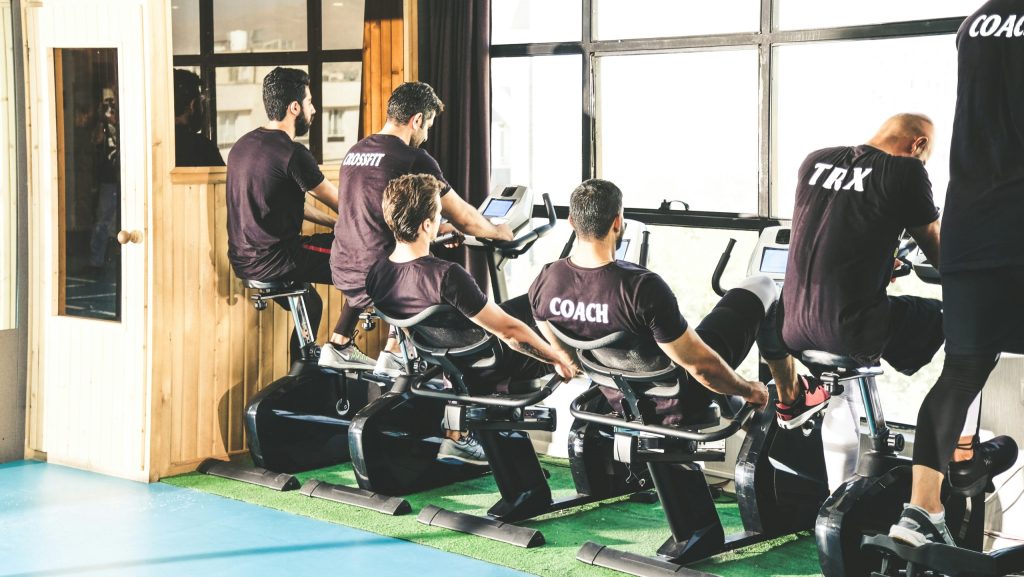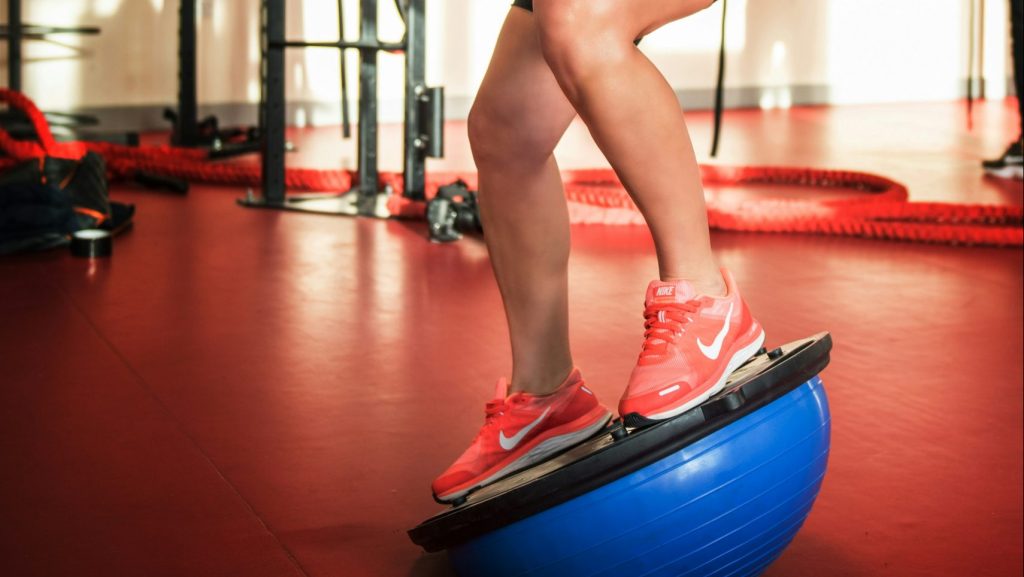Table of Contents
Regularly attending the gym and engaging in repetitive cardiovascular routines can quickly become tedious. This introduction highlights a series of innovative modifications to rejuvenate your indoor cardio sessions, ensuring each gym visit remains effective and interesting.
“Did you know that varying your cardio routine can not only keep it more exciting but also increase its effectiveness?”
Cardiovascular exercise is essential in fitness regimens but often lacks diversity. By introducing variations to traditional treadmill and elliptical workouts, gym-goers can experience enhanced health benefits and renewed interest in their fitness routines. These changes not only make the workouts more enjoyable but also increase their effectiveness by challenging the body in diverse ways.
Incorporating a variety of indoor cardio exercises can help in achieving advanced fitness levels and maintaining high engagement. Whether it involves sprinting, rowing, or cycling, each modified session offers a new challenge that can improve overall fitness.
Explore Innovative Cardio Options
The following sections outline unique modifications to traditional cardio workouts that can transform your experience in the gym:
- Creative Treadmill Routines: Explore treadmill workouts that include sprints, inclines, and even backward running to diversify the routine. These variations not only make the workout interesting but also help burn more calories and strengthen various muscle groups.
- Elliptical Adventure Workouts: Move beyond basic settings with elliptical machines by using pre-programmed courses that simulate different terrains and challenge your stamina, like flat landscapes and steep hills.
- Rowing Machine Exploration: Introduce competitive elements and variable resistance settings in your rowing workouts to mimic the intensity of outdoor rowing, increasing both competitiveness and physical stamina.
- Cycling Sessions That Excite: Enhance stationary cycling with virtual landscapes and rhythmic challenges, using technology to simulate outdoor cycling paths and races.
- Circuit Training for Cardio: Design circuits that incorporate various machines and exercises, such as speed drills and agility tests, to provide a comprehensive workout that improves both strength and endurance.
As you proceed to the detailed sections of this guide, you will find specialized advice and innovative approaches to cardio workouts in the gym. The key to maintaining interest and maximizing workout results is variety. The upcoming sections will help you learn how these dynamic routines can elevate your fitness experience, encouraging consistent engagement and better health outcomes.

Creative Treadmill Routines
Traditional treadmill workouts often involve repetitive, straightforward jogging that can become uninteresting over time. “Creative Treadmill Routines” seeks to expand the use of this common gym equipment by introducing interval sprints, incline challenges, and backward walking, making these routines more diverse and engaging.
Interval Sprints
Interval sprints are a powerful method to enhance traditional treadmill workouts. By integrating high-intensity treadmill intervals, this type of training not only maximizes calorie burning but also significantly boosts cardiovascular health. This technique involves alternating between short, intense bursts of running and periods of lighter jogging or walking, which helps maintain an elevated heart rate throughout the workout.
High-intensity interval training is known to improve aerobic capacity (VO2 max) and is more effective at reducing belly fat compared to steady-state cardio. To implement high-intensity treadmill intervals, set the treadmill to a challenging speed for 30 seconds to one minute, then lower the speed for a recovery period of one to two minutes. Repeat this pattern for 20 to 30 minutes to create an engaging and effective workout.
“High-intensity interval training can increase VO2 max and reduce belly fat more effectively than steady-state cardio.”
Incline Challenges
Treadmill incline training introduces a creative variation to standard cardio routines. Adjusting the incline simulates hill climbing, actively engaging more muscle groups than running on a flat surface. This type of training targets the leg muscles, including calves, hamstrings, and glutes, and is excellent for building strength and endurance.
To benefit from incline challenges, start with a low incline and gradually increase it during the workout. This approach helps avoid muscle strain and progressively intensifies the workout. Incline training not only improves muscle tone and endurance but also increases caloric expenditure as the body works harder to overcome gravitational resistance.
Table: Benefits of Different Incline Levels
| Incline Level (%) | Benefits |
|---|---|
| 1-5 | Suitable for beginners, improves endurance |
| 6-10 | Engages more leg muscles, increases calorie burn |
| 11-15 | Mimics hill climbing, maximizes muscle strength and cardio effort |
Backward Walking
Incorporating backward walking into treadmill workouts offers a unique variation. This method activates muscles that are less commonly used in standard forward walking or running, such as those in the legs and lower back. It enhances balance and promotes muscular symmetry by engaging the posterior chain muscles, which are often underutilized.
For safe backward walking on a treadmill, begin at a slow pace and use the handrails for stability until comfortable with the movement. As proficiency increases, gradually raise the speed. Include short intervals of backward walking combined with forward walking or jogging, or dedicate specific sessions to backward walking, depending on fitness goals and comfort level.
Creative treadmill routines are designed to revitalize standard cardio workouts. By implementing interval sprints, engaging in incline challenges, and incorporating backward walking, these routines not only make treadmill workouts more enjoyable but also more effective. These strategies enhance cardiovascular fitness and introduce diverse challenges, keeping your gym sessions stimulating. Continue exploring each routine in detail to see how they can transform your fitness regimen.

Elliptical Adventure Workouts
Elliptical machines are frequently seen in fitness centers and are excellent for cardiovascular workouts. The “Elliptical Adventure Workouts” are designed to utilize the full capabilities of elliptical machines by introducing variable resistance settings, adventure-themed courses, and strategic heart rate zone training to enhance the cardio session and maintain user engagement.
Resistance Paths
Elliptical workouts that incorporate variable resistance settings allow users to simulate different terrains, enhancing the physical challenge and interest of the exercise. Adjusting the resistance levels mimics the experience of moving through different landscapes, such as gentle hills or challenging mountainous terrain, which can help users achieve specific fitness objectives like improved endurance, increased muscle strength, or higher calorie expenditure.
“Maintaining target heart rate zones during exercise can optimize energy use and increase fat metabolism, making workouts more efficient.”
Users can begin their workout at a lower resistance level and increase it to simulate uphill movement, engaging more muscle groups and intensifying the cardiovascular effort. Lowering the resistance simulates easier downhill paths, which can serve as active recovery periods. This method keeps the workout physically challenging and mentally engaging by varying the intensity and providing a way to achieve a comprehensive cardio session.
Adventure Courses
Elliptical machines often feature pre-programmed adventure courses that simulate real-world trails and landscapes, providing an immersive workout experience. These programs aim to engage the user’s mind and body by changing visual stimuli and resistance settings to reflect different environments. This variety can make the exercise experience more enjoyable and simulate training conditions for outdoor activities like hiking or cross-country skiing.
- Forest trail simulation
- Mountain climb challenge
- Coastal path experience
Heart Rate Zones
Focusing on heart rate zones is essential for maximizing the effectiveness of cardiovascular training on an elliptical machine. Targeting specific heart rate zones ensures that users exercise at the optimal intensity for their personal fitness goals, such as fat burning, improving endurance, or enhancing cardiovascular health.
Ellipticals usually come equipped with heart rate monitoring tools, like hand sensors or wireless chest straps, which help users maintain their exercise within a designated heart rate range. Keeping exercise intensity within a specific zone can optimize calorie burning and enhance overall cardiovascular fitness.
Elliptical adventure workouts enhance standard elliptical routines by including resistance paths, pre-programmed adventure courses, and focused heart rate zone training. These features not only make the workouts more enjoyable but also improve cardiovascular fitness and endurance significantly. As users delve deeper into each of these workout components, they will find effective strategies to rejuvenate their elliptical workouts and achieve their fitness objectives.

Rowing Machine Exploration
Rowing machines provide an effective platform for a comprehensive workout that targets both cardiovascular fitness and muscle strength. This section discusses different aspects of rowing machine workouts, including time trials, stroke variability, and the application of progressive overload principles, tailored to enhance both novice and advanced fitness routines.
Time Trials
Time trials on a rowing machine are structured to challenge one’s endurance and are an effective way to monitor and improve fitness levels. These trials require rowing a set distance or maintaining the highest possible pace for a predetermined time. This form of exercise is beneficial for assessing endurance and cardiovascular improvement.
In practice, time trials are conducted by setting specific distance goals, such as 500 meters for beginners or over 2000 meters for more experienced rowers. This setup helps users focus on maintaining a consistent pace, enhancing endurance, and improving cardiovascular capacity. Regular practice of time trials helps set and achieve measurable fitness targets, contributing to the overall effectiveness of indoor rowing workouts.
“Varying rowing strokes not only prevents monotony but can also increase calorie burn by up to 15% during a workout.”
Stroke Variability
Incorporating a variety of rowing stroke techniques can significantly increase the overall workout efficiency by activating various muscle groups and enhancing rowing skill. Stroke variability involves changes in stroke length, speed, and intensity, which can target different fitness goals such as strength enhancement, speed improvement, and endurance building.
Mastering various rowing phases, like the catch, drive, finish, and recovery, optimizes each stroke’s impact and the workout’s intensity. For instance, emphasizing a strong drive phase can increase muscle engagement and energy expenditure. Alternatively, focusing on the recovery phase can help improve stamina and rowing technique.
Progressive Overload
Applying the principle of progressive overload is essential in rowing to ensure continuous physical development. This approach involves gradually increasing the workout’s resistance, duration, or intensity to challenge the body and enhance fitness levels.
A structured method to implement progressive overload in rowing might include increasing the session’s duration or the stroke rate per minute over time. Here is an example of how to scale up the workout intensity:
| Week | Stroke Rate (strokes/min) | Session Duration (min) |
|---|---|---|
| 1 | 20 | 15 |
| 2 | 22 | 20 |
| 3 | 24 | 25 |
| 4 | 26 | 30 |
Exploring different techniques and strategies in rowing machine workouts can significantly improve cardiovascular health and muscle strength. Time trials, stroke variability, and the application of progressive overload principles are effective methods to enhance workout results. Further exploration of these techniques will allow individuals to fully utilize the rowing machine’s capabilities and achieve comprehensive fitness objectives.

Cycling Sessions That Excite
Cycling sessions are an integral part of fitness routines, known for their cardiovascular benefits and muscle engagement. “Cycling Sessions That Excite” enhance traditional indoor cycling by integrating interactive races, scenic virtual rides, and tempo-based workouts, all designed to maximize enjoyment and fitness outcomes.
Interactive Races
Interactive races use advanced technology to create competitive and engaging cycling experiences that simulate participation in real-world races. These virtual competitions allow cyclists to compete against others in real-time, providing the thrill of racing without leaving the gym or home. This competitive element motivates participants to push harder, enhancing cardiovascular endurance and mental focus.
Virtual races effectively simulate the intensity of outdoor racing, encouraging cyclists to improve their performance through real-time competition. Engaging in these races can lead to increased cardiovascular output and faster fitness gains due to the competitive nature of these workouts.
“Virtual bike races can increase a cyclist’s heart rate by an average of 10%, mimicking the physical demands of actual road racing.”
Scenic Rides
Scenic rides employ visual technology to simulate cycling through diverse environments, from tranquil countryside paths to vibrant urban settings. These indoor cycling classes utilize virtual landscapes to enhance the visual and mental engagement of participants, making the workout more enjoyable and less repetitive.
The benefits of scenic rides extend beyond aesthetic enjoyment, including stress reduction and mood improvement, which are critical for maintaining motivation and performance during workouts. Customizable difficulty settings allow these rides to be adapted for various fitness levels, making them suitable for a broad range of participants.
- Alpine mountains
- Coastal roads
- Urban cityscapes
Music and Tempo
Music and tempo synchronization in cycling workouts align the rhythm of exercise with the beat of music, enhancing the enjoyment and effectiveness of the sessions. This method encourages cyclists to maintain a consistent pace that matches the tempo of the music, which can improve workout intensity and cardiovascular benefits.
Integrating music with cycling sessions helps maintain high energy levels and keeps participants motivated throughout the workout. The synchronization of pedal strokes with music beats not only increases the enjoyment but also contributes to better rhythmic coordination and endurance, making the sessions more effective and engaging.
Cycling Sessions That Excite introduce a new dimension to traditional indoor cycling by incorporating interactive races, engaging virtual environments, and dynamic music synchronization. These elements not only enhance cardiovascular health but also make each workout session more enjoyable and effective. Delve into the specifics of each feature to discover how they can transform your cycling experience and help you achieve superior fitness results.

Circuit Training for Cardio
Circuit training for cardio incorporates a variety of exercise stations that target different aspects of fitness such as cardiovascular health, muscle strength, and agility. This subtopic outlines effective strategies for designing cardio circuit workouts that are scalable across fitness levels, providing an efficient way to enhance physical fitness.
Equipment Variety
The effectiveness of circuit training is significantly increased by incorporating a diverse array of equipment. This approach allows participants to target different muscle groups and improve cardiovascular function in a single workout session. Common equipment includes treadmills for cardiovascular endurance, stationary bikes for lower body strength, rowing machines for stamina, and free weights for resistance training. Rotating through these different stations ensures a comprehensive workout that activates all major muscle groups.
Using a variety of equipment in fitness circuits helps maintain high participant engagement and prevents the typical plateau effect associated with repetitive workout routines. Regular changes in the workout routine prompt continuous muscle adaptation and improvement, crucial for ongoing physical development and weight management.
“Timed stations in circuit training can increase calorie burn by up to 30% compared to traditional workouts, due to their high-intensity nature.”
Timed Stations
Timed stations are fundamental to circuit training, utilizing the principles of high-intensity interval training (HIIT). Participants perform exercises at each station for a set period, typically 30 seconds to a few minutes, followed by a brief rest or transition to a lower-intensity exercise. This structure keeps the heart rate elevated, enhancing calorie burn and maximizing cardiovascular benefits.
The use of timed stations in cardio circuit workouts is known for significantly improving metabolic rates and cardiovascular health. The rapid pace of moving between stations not only makes the session more dynamic but also effectively challenges both the aerobic and anaerobic energy systems, leading to enhanced fitness and endurance.
Skill Challenges
Adding skill challenges to circuit training introduces complexity and enhances overall fitness. These exercises often require balance, agility, and coordination, targeting both physical and cognitive aspects of fitness. Common exercises include:
- Jump ropes for improving coordination and cardiovascular health.
- Agility ladders to enhance quickness and foot speed.
- Plyometric boxes for developing power and leg strength.
Skill challenges not only improve physical strength and endurance but also boost neuromuscular coordination, reaction times, and functional abilities. These activities are particularly beneficial for athletes or individuals looking to enhance their performance in sports or daily physical activities.
Circuit Training for Cardio offers a detailed approach to establishing and benefiting from a dynamic workout routine. By integrating a variety of equipment, implementing timed stations, and including skill-based challenges, these circuits provide a balanced workout that enhances cardiovascular fitness and overall body conditioning. Explore further to learn how to effectively incorporate circuit training into your fitness regimen for optimal health benefits and performance improvements.

Conclusion: Indoor Adventure: Gym Cardio Twists
This article has detailed a series of innovative fitness routines that significantly enhance cardiovascular health, muscle strength, and overall fitness. We have covered a variety of methods from treadmill workouts to dynamic circuit training, each designed to meet the needs of different fitness levels and preferences.
Summary of Key Insights from Each Subtopic
- Creative Treadmill Routines: Enhanced treadmill workouts with interval sprints and incline challenges to improve cardiovascular efficiency and calorie burning.
- Elliptical Adventure Workouts: Utilized programmed courses and resistance settings in elliptical workouts to increase engagement and simulate outdoor activities.
- Rowing Machine Exploration: Focused on the use of various rowing techniques and progressive training methods to boost endurance and full-body strength.
- Cycling Sessions That Excite: Incorporated virtual environments and music synchronization in cycling workouts to make them more enjoyable and effective.
- Circuit Training for Cardio: Employed a mix of equipment and structured timed stations to optimize both cardiovascular and muscular fitness in circuit training sessions.
The diverse workout strategies discussed in this article are designed to cater to a wide range of fitness interests and goals. By adopting these methods, individuals can not only rejuvenate their existing routines but also significantly enhance their physical and mental health. The approaches discussed provide practical and innovative ways to keep fitness routines engaging and effective, ensuring long-term health benefits and improved fitness levels. As you continue to explore and integrate these routines, remember that variety is key to maintaining motivation and achieving comprehensive fitness outcomes. Embrace the changes in your workout regimen, challenge yourself with new exercises, and continue to strive for better health and wellness.